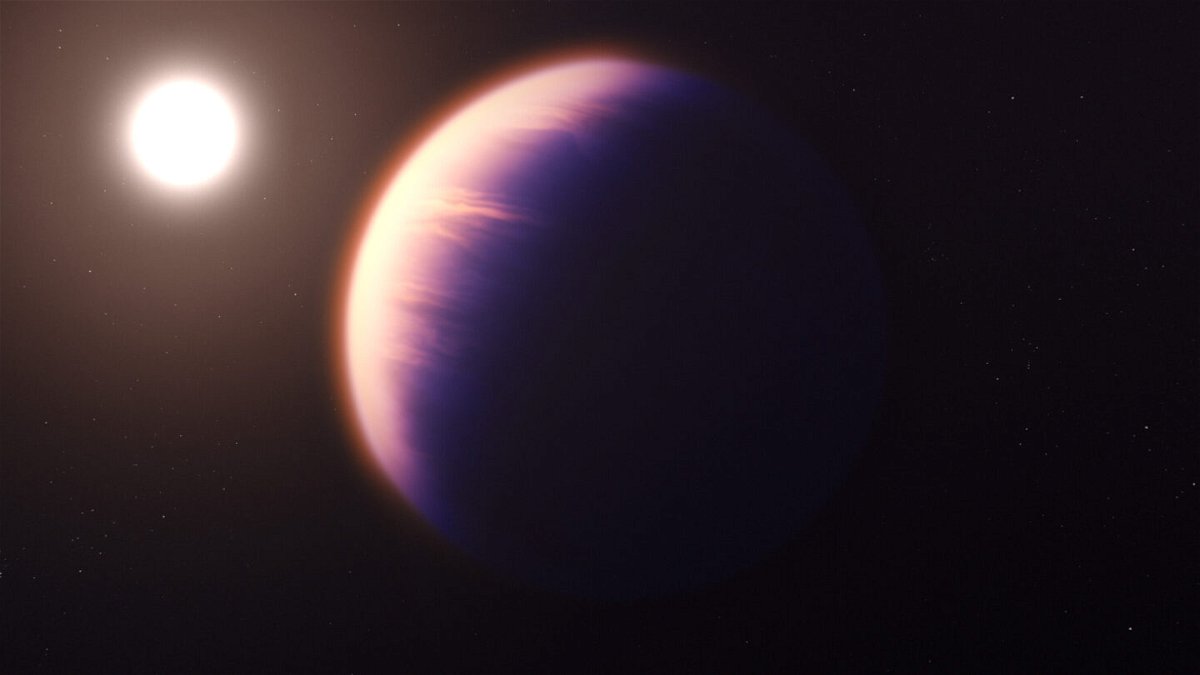NASA’s Webb telescope captures first evidence of carbon dioxide on an exoplanet

By Kristen Rogers, CNN
NASA’s James Webb Space Telescope has captured the first clear evidence of carbon dioxide in the atmosphere of an exoplanet, a planet outside our solar system.
The exoplanet, WASP-39b, is a hot gas giant orbiting a sunlike star that is 700 light-years from Earth and part of a larger Webb investigation that includes two other transiting planets, according to NASA. Understanding the atmospheric makeup of planets like WASP-39b is critical for knowing their origins and how they evolved, the agency noted in a news release.
“Carbon dioxide molecules are sensitive tracers of the story of planet formation,” said Mike Line, an associate professor in Arizona State University’s School of Earth and Space Exploration, in the news release. Line is a member of the JWST Transiting Exoplanet Community Early Release Science team, which conducted the investigation.
The team made the carbon dioxide observation using the telescope’s Near-Infrared Spectrograph — one of Webb’s four scientific instruments — to observe WASP-39b’s atmosphere. Their research is part of the Early Release Science Program, an initiative designed to provide data from the telescope to the exoplanet research community as soon as possible, guiding further scientific study and discovery.
This latest finding has been accepted for publication in the journal Nature.
“By measuring this carbon dioxide feature, we can determine how much solid versus how much gaseous material was used to form this gas giant planet,” Line added. “In the coming decade, JWST will make this measurement for a variety of planets, providing insight into the details of how planets form and the uniqueness of our own solar system.”
A new era in exoplanet research
The highly sensitive Webb telescope launched on Christmas Day 2021 toward its current orbit 1.5 million kilometers (nearly 932,000 miles) from Earth. By observing the universe with longer wavelengths of light than other space telescopes use, Webb can study the beginning of time more closely, hunt for unobserved formations among the first galaxies, and peer inside dust clouds where stars and planetary systems are currently forming.
In the captured spectrum of the planet’s atmosphere, the researchers saw a small hill between 4.1 and 4.6 microns — a “clear signal of carbon dioxide,” said team leader Natalie Batalha, a professor of astronomy and astrophysics at the University of California at Santa Cruz, in the release. (A micron is a unit of length equal to one millionth of a meter.)
“Depending on the atmosphere’s composition, thickness, and cloudiness, it absorbs some colors of light more than others — making the planet appear larger,” said team member Munazza Alam, a postdoctoral fellow in the Earth & Planets Laboratory at the Carnegie Institution for Science. “We can analyze these miniscule differences in the size of the planet to reveal the atmosphere’s chemical makeup.”
Access to this part of the light spectrum — which the Webb telescope makes possible — is crucial for measuring abundances of gases such as methane and water, as well as carbon dioxide, which are thought to exist in many exoplanets, according to NASA. Because individual gases absorb different combinations of colors, researchers can examine “small differences in brightness of the transmitted light across a spectrum of wavelengths to determine exactly what an atmosphere is made of,” according to NASA.
Previously, NASA’s Hubble and Spitzer telescopes discovered water vapor, sodium and potassium in the planet’s atmosphere. “Previous observations of this planet with Hubble and Spitzer had given us tantalizing hints that carbon dioxide could be present,” Batalha said. “The data from JWST showed an unequivocal carbon dioxide feature that was so prominent it was practically shouting at us.”
“As soon as the data appeared on my screen, the whopping carbon dioxide feature grabbed me,” said team member Zafar Rustamkulov, a graduate student of in the Morton K. Blaustein Department of Earth & Planetary Sciences at Johns Hopkins University, in a news release. “It was a special moment, crossing an important threshold in exoplanet sciences,” he added.
Discovered in 2011, WASP-39b’s mass is about the same as Saturn’s and roughly a fourth of Jupiter’s, while its diameter is 1.3 times greater than Jupiter’s. Since the exoplanet orbits very close to its star, it completes one circuit in slightly over four Earth days.
The-CNN-Wire
™ & © 2022 Cable News Network, Inc., a Warner Bros. Discovery Company. All rights reserved.